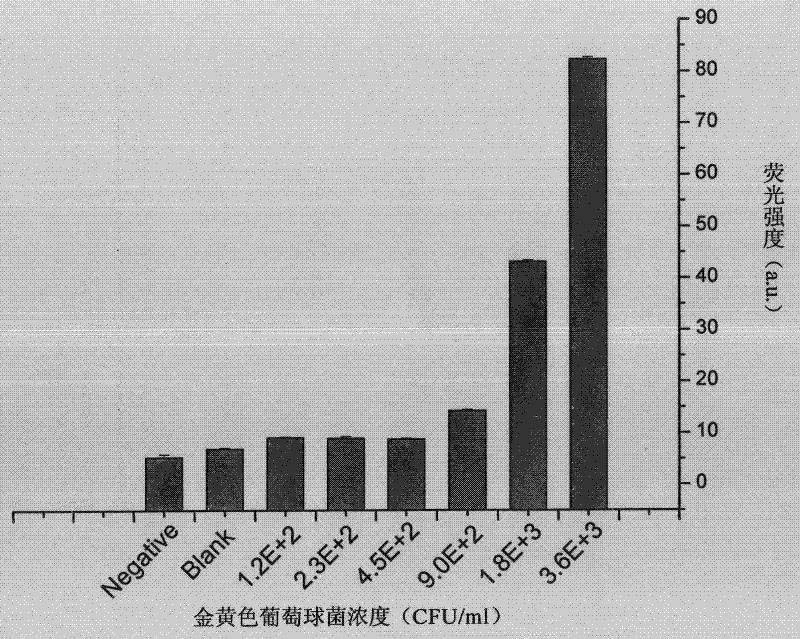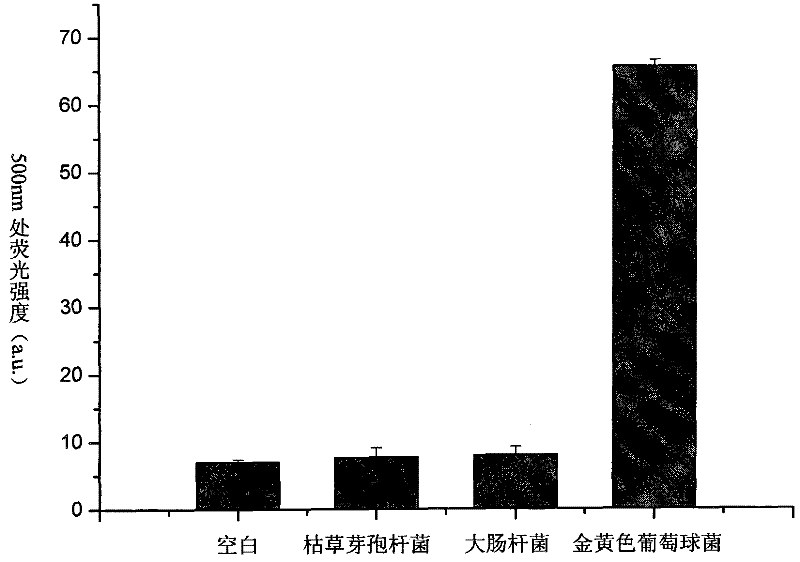Fluorescent probe and method for rapidly detecting staphylococcus aureus by using same
A technology of fluorescent probes and staphylococci, which is applied in the field of environmental sanitation and renewable resource chemical biology, can solve the problems of high technical operation requirements, expensive instruments, unfavorable popularization, etc., and achieve simple process, simple operation, stable and controllable fluorescence The effect of the characteristic
- Summary
- Abstract
- Description
- Claims
- Application Information
AI Technical Summary
Problems solved by technology
Method used
Image
Examples
Embodiment 1
[0027] Carboxymethyl chitosan was dissolved in distilled water at room temperature to configure a concentration of 5mg / ml solution, and 5×10 -3 mol / l cadmium acetate solution, and stirred for 8h to obtain carboxymethyl chitosan cadmium complex. The complex solution was placed in a three-necked flask, protected by nitrogen gas, and quickly added a freshly configured aqueous sodium sulfide solution under high-speed stirring at 2000r / m so that the molar ratio of Cd:S was 1:2, and then continued to mix under nitrogen protection. The system was heated to 80-100 degrees and refluxed for 2 hours to obtain a carboxymethyl chitosan / CdS quantum dot composite solution. The above product was dialyzed in pH=7.5 phosphate buffer for 2 days, purified by gel filtration chromatography (column filler was Sephedex G100), and concentrated to obtain a purified aqueous solution of quantum dots. Dissolve carbodiimide (EDC) and N-hydroxysuccinimide (NHS) in distilled water to make a 500mM solution, ...
Embodiment 2
[0029] Dissolve carboxymethyl chitosan in distilled water at room temperature to configure a concentration of 5mg / ml solution, and add 1×10 -2mol / l cadmium acetate solution, and stirred for 8h to obtain carboxymethyl chitosan cadmium complex. Put the complex solution in a three-necked flask, protect it with nitrogen gas, and quickly add a freshly configured sodium selenide aqueous solution under high-speed stirring at 2000r / m, so that the molar ratio of Cd:Se is 1:1, and then continue under nitrogen protection. The temperature of the system was raised to 80-100 degrees and refluxed for 2 hours to obtain a carboxymethyl chitosan / CdSe quantum dot composite solution. The above product was dialyzed in pH=7.5 phosphate buffer for 2 days, purified by gel filtration chromatography (column filler was Sephedex G100), and concentrated to obtain a purified aqueous solution of quantum dots. Dissolve carbodiimide (EDC) and N-hydroxysuccinimide (NHS) in distilled water to make a 2 μM solut...
Embodiment 3
[0031] Carboxymethyl chitosan was dissolved in distilled water at room temperature to configure a concentration of 5mg / ml solution, and 5×10 -3 mol / l zinc acetate solution, and stirred for 8h to obtain carboxymethyl chitosan zinc complex. The complex solution is placed in a three-necked flask, protected by nitrogen, and is rapidly added with a freshly prepared sodium sulfide aqueous solution under high-speed stirring at 2500r / m so that the molar ratio of Zn:S is 1:1, and then continue to be mixed under nitrogen protection. The system was heated to 80-100 degrees and refluxed for 2 hours to obtain a carboxymethyl chitosan / ZnS quantum dot composite solution. The above product was dialyzed in pH=7.5 phosphate buffer for 2 days, purified by gel filtration chromatography (column filler was Sephedex G100), and concentrated to obtain a purified aqueous solution of quantum dots. Dissolve carbodiimide (EDC) and N-hydroxysuccinimide (NHS) in distilled water to make a 2 μM solution, and...
PUM
 Login to View More
Login to View More Abstract
Description
Claims
Application Information
 Login to View More
Login to View More - R&D
- Intellectual Property
- Life Sciences
- Materials
- Tech Scout
- Unparalleled Data Quality
- Higher Quality Content
- 60% Fewer Hallucinations
Browse by: Latest US Patents, China's latest patents, Technical Efficacy Thesaurus, Application Domain, Technology Topic, Popular Technical Reports.
© 2025 PatSnap. All rights reserved.Legal|Privacy policy|Modern Slavery Act Transparency Statement|Sitemap|About US| Contact US: help@patsnap.com



